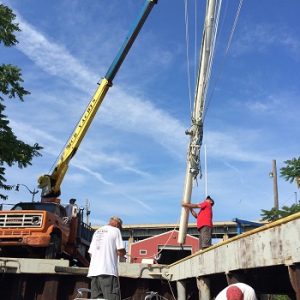In yacht clubs across Canada, as sailboats are hauled-out and winterized, the question always comes up: Should the mast remain up during the winter, or de-masted and stored separately?
“As in most questions related to insurance the answer is: it depends, so contact your boat insurance broker before you make any decision.” stated Andrew Robertson, Senior Vice President, Gallagher Skippers’ Plan.
Some insurance companies require the mast to be removed from the boat when stored on shore. Gallagher Skippers’ Plan policies do not require the mast to be removed in the winter. In our experience, there are more claims for masts being dropped by inexperienced and/or careless owners during launch and haul-out.
The sailboat mast is now the most expensive part of the boat to replace. If your boat is over 20 years old, the cost to purchase a new mast is likely more than the boat is worth. So when the mast breaks the boat is usually a constructive total loss.
A good boat insurance broker, is there to share experience and advise, so that boat owners can make informed decisions.
Here are some considerations for every boat owner who decides to store their sailboat mast-up:
- The majority of rigging failure claims seen by Gallagher Skippers’ Plan boat insurance brokers, involve boats that are laid up ashore with the mast-up. The wind places an additional load on the hull and rigging that reduces the lifespan of wire and rod rigging. It’s difficult for the owner to conduct a proper inspection of the rigging and these two combined can result in a rigging failure accident.
Most policies exclude damage caused by corrosion and normal wear and tear, so Gallagher Skippers’ Plan recommends removing the mast at least every three years for a complete mast inspection and replacing the standing rigging altogether when it’s 20+ years or if it shows signs of damage.
- There have been cases of hull damage caused by boats stored mast-up. The boat is not able to rock in the cradle like it does in the water. In heavy winds you can see the hull flexing and over time the fiberglass can fracture.
This is not considered accidental damage and is not covered by your boat insurance policy.
- Make sure the turnbuckles remain pinned while on shore. Otherwise, vibration can cause the turnbuckle to move causing the mast to fall down accidently.
If the rigging is not properly secured a claim could be denied under the exclusion for “lack of reasonable care in the maintenance of the boat”. This is a good time to check your boat insurance policy.
- Remove all sails before haul-out. If a sail unfurls the boat is likely to be knocked over causing damage to not just your boat, but your neighbours.
- If using jack stands for storage, they must be chained or welded together. It’s not uncommon for cradle pads to go slack due to vibrations, so they should be checked monthly and certainly before any winter storms.
NEVER secure winter covers to the jack stands. The cover acts like a sail and can pull the jack stand loose.
- Another great reason to check your boat monthly during the winter is to ensure there is adequate drainage at the base of the mast. We’ve seen damage caused by the bottom two feet of the mast filling with water and freezing causing the bottom of the mast to split open.
Freezing damage is not covered by insurance.
- Ice and snow can damage the wind instrument at the mast head so, our boat insurance brokers recommend removing it before haul out.
At Gallagher Skippers’ Plan, we develop strong relationships with our clients. Our seasoned marine insurance brokers are here to years of boating experience and knowledge. We want to be your first call!
Discover why boaters have trusted Gallagher Skippers’ Plan
with their boat insurance for over 70 years!
Get an online quote today!
 Gallagher Skippers’ Plan Boat Insurance
Gallagher Skippers’ Plan Boat Insurance
800-661-7211 | 416-789-7211
Report a Claim | Contact a Boat Insurance Specialist

